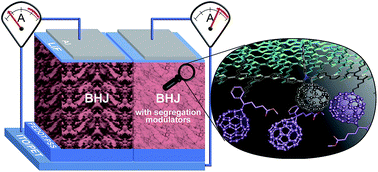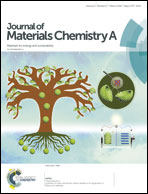Enhanced power-conversion efficiency in organic solar cells incorporating copolymeric phase-separation modulators†
Abstract
A new class of copolymers containing oligothiophene moieties with different lengths and fullerene units have been designed and prepared by an easy and inexpensive one-step synthetic approach. The incorporation of small quantities of these copolymers into bulk heterojunction (BHJ) solar cells with donor regioregular polythiophene (P3HT) and an acceptor fullerene derivate (PCBM) results in good control of the phase separation process without further affecting the BHJ optoelectronic properties. Indeed, under thermal annealing these copolymers allow the modulation of the growth of domains whose size depends on the length of the copolymer repetitive units. Domain size on the same length scale as the P3HT exciton diffusion length with a good continuity between the electrodes gives efficient exciton dissociation and charge mobility. Thus by employing copolymers containing oligothiophenic chains with a size of about 8 nm, the power conversion efficiency (PCE) (4.46%) and short current density (JSC) (16.15 mA cm−2) values are the highest reported so far for P3HT:PCBM solar cells on plastic substrates.



 Please wait while we load your content...
Please wait while we load your content...